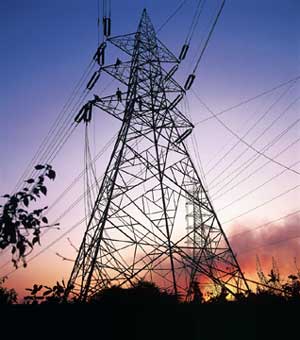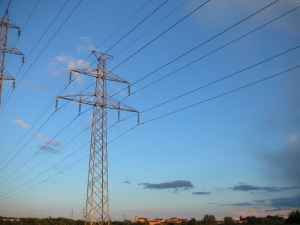CapX2020 – why not build?
February 16th, 2007

What’s the point of CapX 2020 and all the transmission expansion? Why, look at the map — they want to move electricity from the coal fields of the Dakots to Wisconsin (dig those dotted lines east and west). Why? Duh, well duh, to make money in the bulk power market, making bulk power transactions. So why are they trying to say they need it, that WE need it if we’re going to institute a Renewable Energy Standard? Because then we’ll pay for it. And they’re worried maybe we won’t.
Do you know that they’ve asked the PUC for an exemption to the meat of the “need” rules.
Why exempt it from filing requirements? Because they think we’re chumps enough to pay for it. But “need†is different than “we want it for bulk market transactions†and “we want it for profit.†And if it’s for their profit, and we’re not getting benefit, explain why we should pay for it? If they’re not exempt, they have to justify the lines, and if they’re exempt, they don’t have to answer those difficult questions!
They rush to build because there’s money in them thar lines! Here’s the poop from MISO:
Results Show Midwest ISO Energy Markets Bring Tangible Benefits to Nation’s Largest Power Grid ; Midwest ISO also advances two initiatives — a transmission expansion plan and an ancillary services market — to support markets in the future.
Feb 15, 2007 – PR NewswireCARMEL, Ind., Feb. 15 /PRNewswire/ — Results of a cost/benefit analysis show that two components of the Midwest ISO’s energy market brought $58 million in financial benefits – or an annualized figure of almost $70 million – to market participants during a 10-month study period. Summary results of the study, conducted by Virginia-based ICF International, were released to stakeholders today.
“These results show that we’re accomplishing one of our goals: bringing financial benefits to the region. This is in addition to our goals of improving reliability and promoting infrastructure growth, despite the challenges of creating the nation’s largest geographic ISO,” said T. Graham Edwards, President and CEO of the Midwest ISO. “The Midwest ISO is still a young organization and benefits will continue to grow as we mature and add services.”
The ICF study highlights the differences between realized and potential benefits, focusing on a subset of operational benefits: regional unit commitment and utilization of transmission assets. If Midwest ISO’s proposed Ancillary Services Market had been operational, the total potential benefits would increase by $189 million to a total of $460 million over the 10-month period, the study said. The Midwest ISO hopes to launch its Ancillary Services Market in the spring of 2008.
The study analyzed market information from more than 100 Midwest Market participants for the period of June 2005 through March 2006. Midwest ISO has asked ICF International to analyze an additional five months (April through August 2006) to provide more data on the cost/benefit of Midwest ISO’s impact and to analyze a second summer season.
ICF International is expected to release the study’s methodologies and assumptions at the end of February 2007.
Financial Benefits Will Grow As Midwest ISO Adds Services
Also today, the Midwest ISO Board of Directors approved the Midwest ISO Transmission Expansion Plan 2006 (MTEP 06), a far-reaching, long- term transmission expansion plan that recommends $3.6 billion in additional transmission infrastructure and improvements in the Midwest. This initiative is expected to reduce congestion costs by $2 billion annually.
MTEP 06 provides a comprehensive, top-down reliability evaluation of the expected performance of the region’s transmission system through 2011. Highlights include:
* $2.1 billion in committed projects by participating Transmission Owners
through the year 2011 and forecast of an additional $1.5 billion for
the same period;* Elimination of 22 of the top 30 constraints to market operations;
* Five recommended expansion plans specifically addressing constraints in
the newly identified Narrowly Constrained Area in Eastern Iowa and
Minnesota;* Facilitation of new generation entry by providing expansions to
accommodate 14,400 MW of new generation supply, including 2,810 MW of
renewable resources; and* Provision for footprint-wide expansions at all transmission voltage
levels including commitments for four new 345 kV and two 230 kV lines
for service by 2011.The $3.6 billion in expansion plans are in addition to the $13 billion in existing transmission investment within the Midwest ISO, and represent a $700 million increase in identified investment since the prior plan was issued in June 2005.
Since the Midwest ISO began regional planning, nearly $1 billion in new infrastructure and infrastructure improvements have been brought on- line within the Midwest ISO’s footprint. These include more than 460 miles of new transmission lines, nearly 2,400 miles of upgraded transmission lines, and numerous improvements to substations and other transmission facilities.
Finally, the Midwest ISO is filing with the Federal Energy Regulatory Commission (FERC) for the establishment of its Ancillary Services Market by close of business today, February 15. This filing represents a significant step in the evolution of the Midwest ISO markets as the Midwest ISO continues to enhance the efficiency of the markets while maintaining the same high degree of reliability with which the Midwest ISO has operated since its formation. The Midwest ISO believes that these proposed tariff changes, which are the result of over two years of analysis and evaluation and also encompass the best design elements of other ISO/RTO markets, will:
* Increase the efficiency of the existing Midwest ISO Day-Ahead and Real- Time Markets while minimizing total costs;
* Incorporate changes to accommodate the transfer of certain Balancing Authority functions to the Midwest ISO;
* Provide for efficient acquisition of the pricing of Operating Reserves;
* Present the mechanism for increased competition through additional available resources (including Demand Response Resources); and
* Complement the short-term markets price signals by encouraging resources to provide additional flexibility.
About the Midwest ISO
The Midwest ISO ensures reliable operation of, and equal access to, 93,600 miles of interconnected, high-voltage power lines in 15 U.S. states and the Canadian province of Manitoba. The Midwest ISO manages one of the world’s largest energy markets, clearing more than $2 billion in energy transactions monthly. The Midwest ISO was approved as the nation’s first regional transmission organization (RTO) in 2001. The non-profit 501(C)(4) organization is governed by an independent Board of Directors, and is headquartered in Carmel, Indiana with operations centers in Carmel and St. Paul, Minnesota. Membership in the organization is voluntary.
For more information, visit www.midwestmarket.org.
Xcel screws up service again
February 9th, 2007
… there they go again, sending out their “Request for Exemption from Certain Certificate of Need Application Content Requirements,” and of course they didn’t serve one on moi. They didn’t serve anyone from Prairie Island either.

Here’s the Request they don’t want me to have:
I think it’s about time to have this docket thrown out for process errors. I’ve asked for the Comment period to be set back 10 days, because by the time they get around to getting me served… and I note they didn’t serve Prairie Island either. Maybe I can bring my grrrrrrls and Lori Michel can bring her SIX chihuahuas…
RES doesn’t require transmission!
February 8th, 2007
Everybody’s cheering the passage of SF 004 – the Renewable Energy Standard. But why does the Senate open the door to more perks for market transactions — bulk power transmission? That’s not a good thing… we don’t need transmission. READ THE WIND INTEGRATION STUDY – HERE!!
Here’s the problematic part of SF004 (CLICK HERE FOR LINK):
Sec. 2. TRANSMISSION FOR RENEWABLE ENERGY STANDARD.
Minnesota electric utilities, as defined by Minnesota Statutes, section 216B.1691,
Subdivision 1, paragraph (b), must study and develop plans for the transmission network enhancements necessary to support the renewable energy standards and milestones established in Minnesota Statutes, section 216B.1691, subdivision 2a. The study process must be designed to identify and optimize delivery of that renewable energy to Minnesota retail customers while maintaining system reliability.
As part of the planning process, Minnesota electric utilities shall incorporate and build upon the analyses that have previously been done or that are in progress, including, but not limited to, the 2006 Minnesota Wind Integration Study and ongoing work to address geographically dispersed development patterns. The Minnesota electric utilities shall collaborate with the Midwest Independent System Operator to optimize and integrate to the extent possible Minnesota’s transmission plans with other regional transmission considerations.
As part of the planning process, utilities shall convene and regularly consult with a group of stakeholders with experience and expertise in transmission system engineering and renewable generation technology to review the study’s proposed methods and assumptions, preliminary results, and ongoing efforts.
Utilities shall submit a report to the Minnesota Public Utilities Commission by November 1, 2007, describing the activities undertaken pursuant to this section. The report shall include:
(1) a description of the analyses that have been undertaken and the results, including the critical issues that need to be addressed in order to develop the transmission needed to meet the standards and milestones of Minnesota Statutes, section 216B.1691, subdivision 2a;
(2) a comprehensive conceptual plan to guide ongoing planning efforts to develop the transmission necessary to support those standards and milestones;
(3) specific transmission line proposals necessary to meet those intermediate standards and milestones;
(4) a description of how the results of these studies have been reflected in the biennial transmission reports filed under Minnesota Statutes, section 216B.2425; and
(5) a five-year action plan that identifies with specificity the actions necessary to implement the specific proposals and to refine and further develop the transmission plans needed to support those standards and milestones, including initiating any certificate of need or other regulatory proceeding necessary to implement the specific proposals identified above.
Why is this in here? Wasn’t the 2005 Transmission Omnibus Bill from Hell enough? Why aren’t we repealing the noxious parts of that bill?
HUH?? Oh, great idea…
Don’t tie CapX2020 anchor to RES
February 1st, 2007
STUPID LEGISLATIVE TRICKS ALERT!!!
CapX2020 facilitates coal, and does it quite nicely! And no, that’s not a good thing…
CapX2020, a multi-BILLION dollar transmission project, is spending a lot of time and money at the legislature. They get a full House Energy Committee meeting to sell their sob story, and the only testimony allowed is from those who have a vested interest in CapX2020 (TRANSLink). Why do the get so much time for their sales pitch? Why are they getting any time at all? I’ve been told “oh, they don’t want anything.” Right… oh, pleeeeeze…
CapX2020 will want to latch onto the RES claiming that renewables can’t be added without the transmission.
Capx2020 claims they need to “streamline” and of course will want to gut the Certificate of Need and/or environmental review. CapX2020 (TRANSLink by another name) and WoW have consistently advocated for gutting of state review, abdicating to federal non-review.
200,000 landowners across MN are affected by CapX. Of course they don’t want to have any review!!!! Particularly at a time when Dept. of Commerce analysis shows both Big Stone transmission (and plant) and the Mesaba Project are not needed/not in the public interest. They can’t prevail under the rules so we should change them just for them… the arrogance!
1) RES can easily be done once or twice over without significant transmission additions — RES renewables can be sited carefully and effectively and save us billions AND it doesn’t facilitate coal.
2) Streamlining is desired only because they cannot prove need — and when it’s not needed, why would we spend billions to build it?
3) Any project in the BILLIONS must have full review — it’d be nuts to exempt it!
4) If CapX 2020 were to be exempted from environmental review, then 200,000 landowners would not have recourse of “Buy the Farm” where they can elect for utility to buy out the entire parcel so they can move away from the line. Minn. Stat. 116C.63, Subd. 4. This would screw over 200,000 Minnesota landowners, great policy idea, eh?
Given the Waltons have been shamelessly promoting CapX2020, if this proposal comes up, who will oppose it? I don’t know of anyone who has resources/funding to do that. Just remember that when it comes to CapX2020, the Izaak Walton League is promoting their self interest, and not the public interest, and not representing “environmental” groups. And of course there are those of us doing what we can with what we’ve got to shine a light on CapX2020!
CapX2020 for RES? Yesterday at the capitol
January 30th, 2007
Question of the Day: WHAT DOES CAPX2020 WANT NOW?
Here’s my House Energy presentation that didn’t happen:
Once more with feeling… Question of the Day: WHAT DOES CAPX2020 WANT NOW?
CAPX 2020 for RES??? Streamlining?
Exempt from what… Certificate of Need?
Environmental review?
I don’t think so… Over my dead polar bear!
Why are they before the legislature? Didn’t they get it all in the 2005 transmission bill? Other than an exemption from all regulation and review — so that must be what they want, eh? No Renewable Electricity Standard without more transmission?
I’m really tired of these “little bit of wind for noxious generation” deals…
Minutes of October 19 2006 MAPP NM-SPG meeting state:
Ed Weber noted that the Coalition coal generator location is expected to be announced sometime early in 2007.
Anyone want to put any $$$ on that one?
It’s time to effectively deal with the transmission lies of Wind on the Wires, and their agreements with NSP/Xcel that grew from the 2002 SW Minnesota 345kV case. To watch Beth Soholt represent that proceeding to legislators as one where they got conditions to the Certificate of Need that would limit coal (a logical and legal impossibility) and as one where landowners were behind it because they got something out of it, that’s too much. Their entire purpose is to promote transmission, and they’ve done a good job of it. It has nothing to do with the public interest, nothing positive, that is, and has everything to do about the purposes of the Wind on the Wires grant — it’s a grant, not an organization, it’s just like the Great Plains coal work group — they’re paid to promote transmission.
For years, Soholt as Izaak Walton staff, and Matt Schuerger as ME3 staff, were attempting to gain SEED buy-in. They advocated for transmission in other venues too, promoting transmission generally, weakening of state jurisdiction and strengthening of federal jurisdiction, alteration of criteria for Certificate of Need particularly toward a regional focus — how is any of this in the public interest? How is any of this within the mission of the Izaak Walton League? Within the mission of ME3? Do their constituents know what they’re doing?
The sell-out by Minnesota’s so-called “environmental” groups has been apparent for a long time, starting with the Izaak Walton League and ME3, and including Minnesota Center for Environmental Advocacy and George Crocker’s North American Water Office on the deal for the SW Minnesota 345kV line. That sell-out was codified in the 2005 Transmission Omnibus Bill from Hell. My awareness of it began a couple of days before September 6 or 8, 2001, months prior to the filing of the SW MN 345kV Application, when Beth Soholt and Matt Schuerger asked six or seven of us potential intervenors to sell out on the line, errrrr… to “approve” of the line. At the time, Beth was working for Izaak Walton League and I think Matt was still with ME3 (he’s now contracting with the state). The perceived problematic potential intervenors were myself, the only attorney of the group, Bill Neuman, Sig Anderson, Dan Juhl, George Crocker and Dave Benson (two others have agreed to sign affidavits about this meeting). I’d requested the SW transmission study, which I still have, and was up at 6 that morning to review it. What was obvious to me was that when they listed generation waiting that required the line, it was coal, a big long list (see SW MN/SE SD Transmission Study, Section 7.2, p. 29-30). Soholt’s and Schuerger’s line was that it was needed for wind, but a 345kV line doesn’t do a thing for wind — yet that 345kV part was what they were insistent about. Wind interconnects, even large projects, to at most a 115kV line, well, logically it could connect to anything, but there’s not enough in one spot to justify the size of the line that was proposed, 2,085 MVA capacity, and the cost for wind to interconnect to that is prohibitive. The 345kV line ran from Sioux Falls (Split Rock) to Lakefield Junction, with just one interconnect from Buffalo Ridge, at Nobles. At that substation, the powerflows show that there’d be 213-302MW coming off of Buffalo Ridge, a very small percentage of the capacity of the line. At the time, I asked about Big Stone II, the logic user of that transmission. I pointed to the list of coal plants in the draft study, and asked what would limit that 345kV line from being used as the logical purveyor of coal, and he got snippy and pissy, and of course had no answer. I also said that obviously they were getting something, and were they willing to share? And got another pissy snippy answer, he threatened to walk out of the meeting again, hey, please do! I was there for the duration to find out what was up, and what struck me most was the “B squad” nature of the approach, there was no sell, no offer of anything that would justify selling out on that line. All they did was alert me to their selling out and promotion of that line and the importance of stopping that line because it really would facilitate coal.
Right after that came the Buffalo Ridge Transmission Plan, designed to address REAL wind collection and integration into the grid, and to expose the lie of the 345kV line. In disgust at the Soholt/Schuerger proposal, it was clear another means of achieving wind development was needed, and here it is:
I’ve got to dig up my notes here… this will be a multi-part piece.





